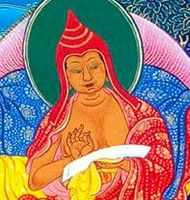Haribhadra
Jump to navigation
Jump to search
སེངྒེ་བཟང་པོ་
| Wylie | seng+ge bzang po |
|---|---|
| English Phonetics | Haribhadra |
Dates
| Birth: | c. 800 |
|---|
Tibetan calendar dates
About
- Religious Affiliation
- Yogācāra-*Svātantrika
- Teachers
- Vairocanabhadra
Other Biographical info:
Links
- Wiki Pages
Buddha Nature Project
- Person description or short bio
- Haribhadra. (T. Seng ge bzang po) (c. 800). Indian Buddhist exegete during the Pāla dynasty, whom later Tibetan doxographers associate with the Yogācāra-*Svātantrika syncretistic strand of Indian philosophy. He may have been a Student of Śāntarakṣita and was a contemporary of Kamalaśīla; he himself lists Vairocanabhadra as his teacher. Haribhadra is known for his two commentaries on the Aṣṭasāhasrikāprajñāpāramitāsūtra ("Prajñāpāramitā in Eight Thousand Lines"): the longer Abhisamayālaṃ kārālokā-Prajñāpãramitãvyãkhyã, and its summary, the Abhisamayālaṃkāravivṛti. He is also known for his recasting of the twenty-five-thousand-line version of the prajñāpāramitā (Pañcaviṃśatisāhasrikāprajñāpāramitāsūtra) in a work entitled the Le'u brgyad ma in Tibetan. Each of these works is based on the interpretative scheme set forth in the Abhisamayālaṃkāra ("Ornament for Clear Realizations"), a guide to the Pañcaviṃśati that Haribhadra explicitly attributes to Maitreya. His Abhisamayālaṃkārālokā builds upon Pramāṇa, Madhyamaka, and Abhidharma literature and was extremely influential in Tibet; its summary (known as "’grel pa don gsal" in Tibetan) is the root text (rtsa ba) for commentaries in the Gsang phu ne’u thog monastery tradition originating with Rngog Blo ldan shes rab. It is the most widely studied prajñāpāramitā commentary in Tibetan Buddhism to the present day. Haribhadra is known for his explanation of a jñānadharmakāya (knowledge truth-body) in addition to a svābhāvakāya, viz., the eternally pure dharmadhātu that is free from duality. He is characterized as an alīkākāravādin ("false-aspectarian") to differentiate him from Kamalaśīla, a satyākāravãdin ("true- aspectarian") who holds that the objects appearing in the diverse forms of knowledge in a buddha's all-knowing mind are truly what they seem to be. He cites Dharmakīrti frequently but appears to accept that scripture (āgama) is also a valid authority (pramāṇa). There are two principal commentaries on his work, by Dharmamitra and Dharmakīrtiśrī. Buddhaśrījñāna (or simply Buddhajñāna) was his disciple. The Subodhinī, a commentary on the Ratnaguṇasaṃcayagāthā, is also attributed to him. (Source: "Haribhadra." In The Princeton Dictionary of Buddhism, 345. Princeton University Press, 2014. http://www.jstor.org/stable/j.ctt46n41q.27.)
Expand to see this person's philosophical positions on Buddha-nature.
| Is Buddha-nature considered definitive or provisional? | |
|---|---|
| Position: | |
| Notes: | |
| All beings have Buddha-nature | |
| Position: | |
| If "Qualified", explain: | |
| Notes: | |
| Which Wheel Turning | |
| Position: | |
| Notes: | |
| Yogācāra vs Madhyamaka | |
| Position: | |
| Notes: | |
| Zhentong vs Rangtong | |
| Position: | |
| Notes: | |
| Promotes how many vehicles? | |
| Position: | |
| Notes: | |
| Analytic vs Meditative Tradition | |
| Position: | |
| Notes: | |
| What is Buddha-nature? | |
| Position: | |
| Notes: | |
| Svātantrika (རང་རྒྱུད་) vs Prāsaṅgika (ཐལ་འགྱུར་པ་) | |
| Position: | |
| Notes: | |
| Causal nature of the vajrapāda | |
| Position: | |
